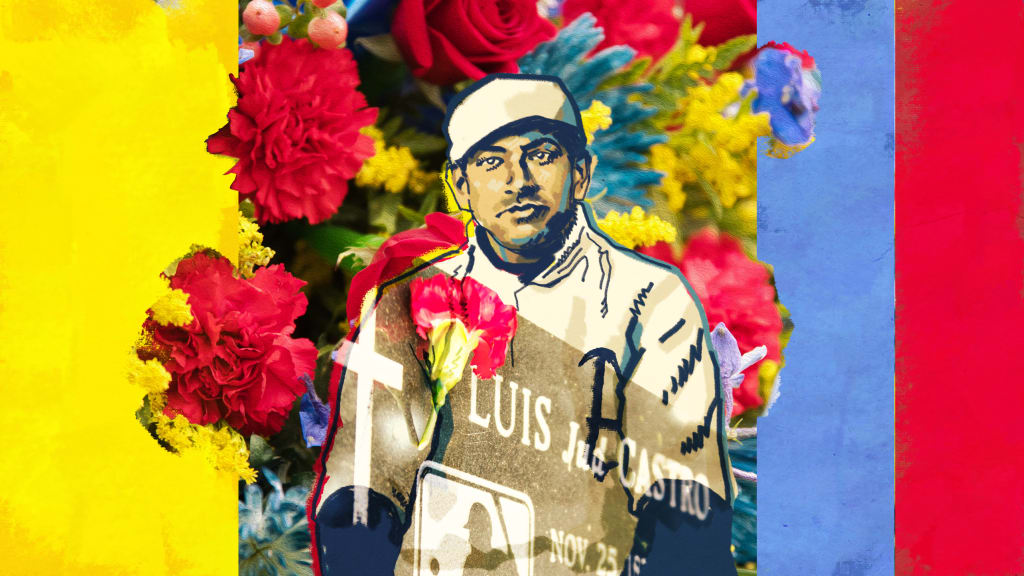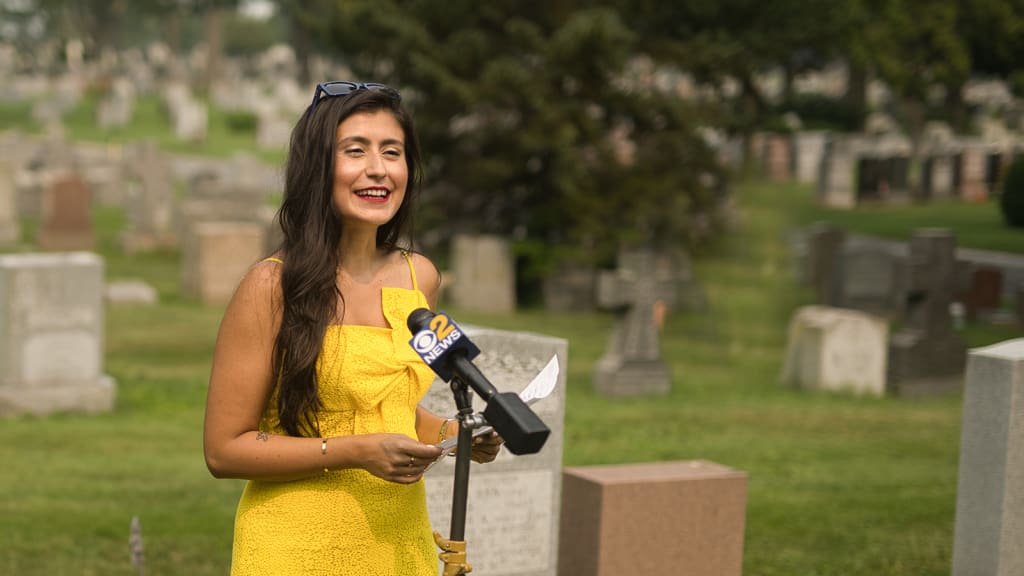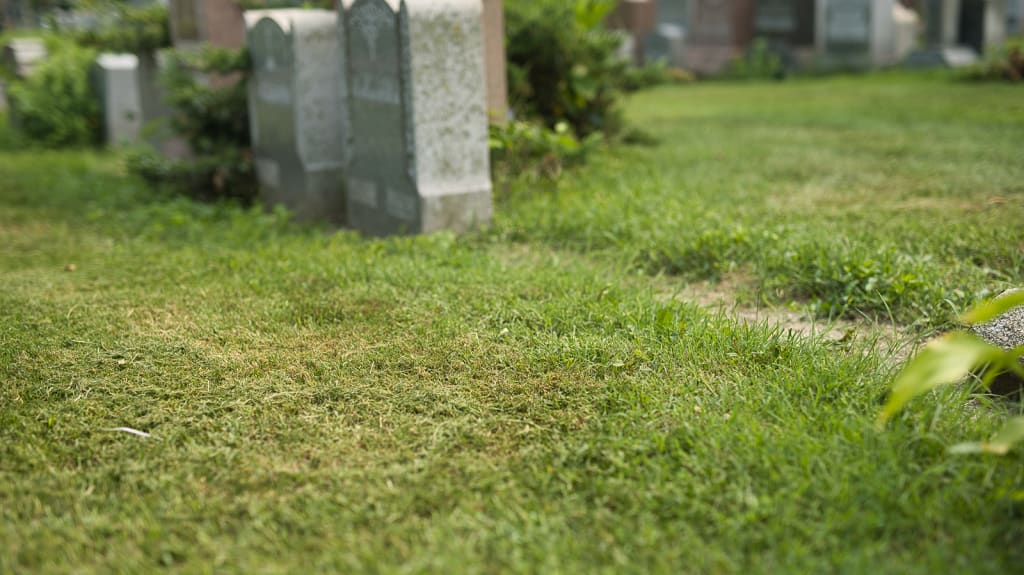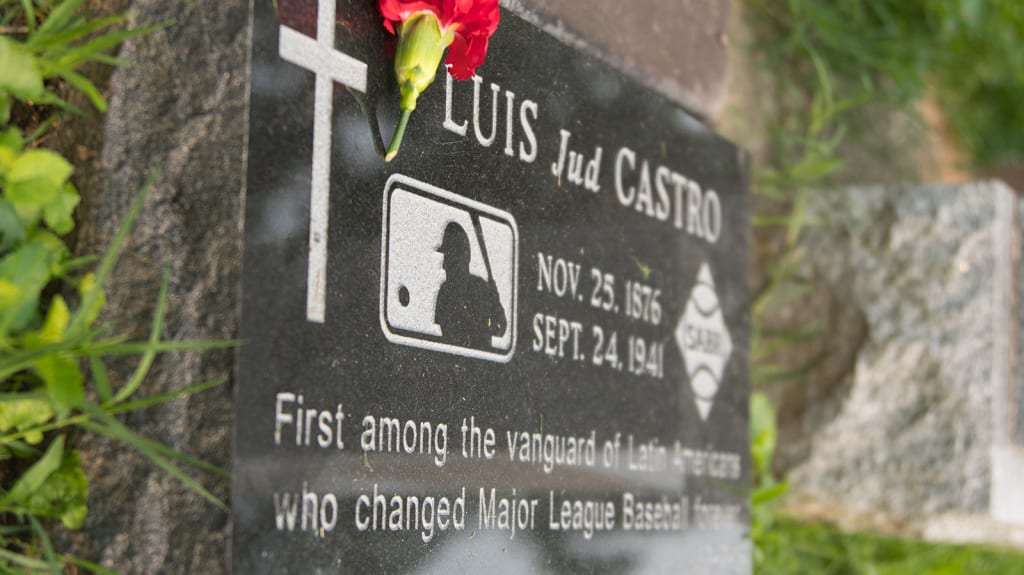
From Sept. 15-Oct. 15, MLB.com is celebrating Hispanic Heritage Month by highlighting stories that pay tribute to some of the most significant and talented players from Latin America in the game's history.
A version of this article was first published in September 2021.
---
Jessica Ramos grew up in Queens at a time when her Colombian heritage was not easily worn. She is the daughter of an undocumented seamstress and a printing pressman who at one time had settled in Jackson Heights, a neighborhood with a heavy Colombian population that -- in Ramos’ formative years in the 1980s and 1990s -- was known primarily for the presence of drug cartels. Newspapers described the area as New York’s “cocaine capital.”
This unflattering association, this displeasing place in the city’s hierarchy, was one a young Colombian-American like Ramos could not escape. And so, as she reached adulthood and began to have aspirations of making an impact on her home turf, Ramos decided to research other Colombians who had settled in the States and made more positive contributions to society.
That’s how she came across the name Luis Castro, a Colombian-born baseball player.
Then she found out he was buried right there in Queens.
“My jaw dropped,” Ramos says.
As Ramos learned, Castro was not only baseball’s first Colombian-born player but also the first player from any Latin American country to appear in a recognized Major League game. A second baseman for the 1902 Philadelphia Athletics, he had kept his birthplace a secret -- supposedly out of fear of deportation -- and died penniless. It was decades after his death and burial in an unmarked grave at Mount St. Mary Cemetery in Flushing that his significance to baseball history was realized by researchers.
So in 2019, when Ramos was elected to the New York State Senate to represent District 13 -- the district that includes the Queens neighborhoods where she grew up and the Mets’ home at Citi Field -- her first order of baseball business was to ask that MLB look into Castro’s story and the burial plot so unbecoming of his importance.
Fortunately, there is a little-known committee in place for just such a task.
* * * * * * * *

Jim Creighton’s grave at Brooklyn’s Green-Wood Cemetery was described by a Brooklyn Daily Eagle reporter in 1866 as “the Mecca of ball players, the sole relic of the noblest and manliest exponent that the national game has ever had.”
Though not commonly known to baseball fans today, Creighton’s importance cannot be overstated. With his swift underhand tosses and snap of the wrist, he revolutionized pitchers’ deliveries and permanently altered the relationship between hurler and batter, from cooperative to adversarial. Creighton was imitated enough to necessitate the creation of the strike zone and the first alteration of the distance between pitcher and hitter. He was baseball’s first superstar.
He also died young.
In 1862, at the age of 21, Creighton passed away from a ruptured abdominal hernia that had gone undiagnosed -- a condition perhaps caused either by his violent delivery or a particularly aggressive swing at the plate. Ballplayers from that era grieved his loss. For years, clubs passing through Brooklyn would stop to pay their respects to Creighton at his grand grave site, which included a 12-foot marble obelisk crowned by a large marble baseball.
But then… time happened.
As the game modernized and Creighton’s memory faded into the background, those tributes from baseball travelers ceased. And as the decades passed, Creighton’s gravesite -- quite possibly the first-ever baseball monument -- fell into disrepair. The marble baseball disappeared altogether.
In 2014, a group of baseball fans and historians rectified the situation. Through fundraising efforts and a generous donation from sports journalist and political commentator Keith Olbermann, a hand-carved replica of the marble topper was placed atop Creighton’s monument and a bronze plaque proclaiming him “America’s First Baseball Star” was placed at the grave’s base.
This work was not without precedent. Since 2004, the Negro Leagues Baseball Grave Marker project -- an effort started by an anesthesiologist named Jeremy Krock and supported by the Society for American Baseball Research (SABR) -- has raised funds to put proper headstones on the graves of dozens of Negro Leaguers. The experience with Creighton’s grave compelled SABR members to launch a similar initiative for influential players from professional baseball’s formative years.
“We’re not honoring cup-of-coffee types,” says John Thorn, official MLB historian and member of SABR’s 19th Century Grave Marker Project Committee. “The grave marker committees in both the Negro Leagues and at the 19th century level are looking for very interesting, significant figures.”
Since its official inception in 2015, the 19th Century Grave Marker Project has dedicated new grave markers at the burial sites of the following figures:
• James Whyte Davis, an early and longtime member of the formative New York Knickerbocker Base Ball Club. He is buried in Brooklyn.
• Andy Leonard, a star left fielder for the Cincinnati and Boston Red Stockings in the 1870s. He is buried in Boston.
• Pud Galvin, a Hall of Fame pitcher who won 365 games, primarily for the National League’s Buffalo Bisons, between 1875 and 1892. He is buried in Pittsburgh.
• Bob Caruthers, a pitcher and hard-hitting outfielder for the St. Louis Browns and Brooklyn Bridegrooms in the 1880s. He is buried in Chicago.
• Hicks Hayhurst, a player for and president of the National Association’s Philadelphia Athletics who in 1869 helped organize the first widely reported integrated baseball game in U.S. history. He is buried in Philadelphia.
Major League Baseball makes an annual donation to help these projects reach their completion.
“These are unfinished stories getting an ending,” says Ralph Carhart, a SABR member who, until recently, chaired the 19th Century Baseball Grave Marker Project Committee. “There’s a sense of completion that comes with putting this coda on these guys who shaped the game. The ones we placed stones for all, in one way or another, played a role in developing the game we know today.”
Though Castro only loosely qualified for a project centered on the 19th century (his professional career began in 1898, but the entirety of his Major League career took place in that 1902 season), his case was compelling enough to get the go-ahead from the committee. Particularly after Sen. Ramos’ passionate urging.
But much like the story of Castro’s life, granting him a suitable headstone would prove complicated.
* * * * * * * *

Baseball pioneer and Civil Rights icon Jackie Robinson wore No. 42 as he broke into the big leagues and embarked on a Hall of Fame career in the face of racial prejudice. That number is now retired across the sport.
Luis Castro? He played just 42 games in the bigs. And were it not for his place of birth, those 42 games would be significant only for who he replaced, not what he accomplished.
Castro’s debut occurred as a result of highly unusual circumstances.
After dropping out of Manhattan College to play ball for a variety of semi-pro teams, he was signed by the legendary Connie Mack out of the Connecticut State League as a utility player for 1902. The A’s starting second baseman was Hall of Famer Nap Lajoie, who in 1901 had been one of many players from the National League who jumped ship to the newly created American League for a richer pay day.
The Philadelphia Phillies, citing the reserve clause, challenged Lajoie’s move to the crosstown A’s in court, and the proceedings played out for a year. It was not until April 1902 that the Pennsylvania Supreme Court ruled in favor of the Phillies, barring Lajoie from playing for any other team in the state. The injunction was delivered during the A’s Opening Day game in Baltimore, and Lajoie was pulled from the field in the ninth inning.
So in came Castro.
While Lajoie went on to be dealt from the Phillies to the AL’s Cleveland club, the 25-year-old Castro tried to fill his big shoes. Castro hit pretty well initially, but his performance quickly tapered off. And his defense was not up to snuff. Per the records at Baseball Reference, he hit .245 while making 14 errors at second base and another five at shortstop and in the outfield. He played sparingly in the second half for the American League champions and was released prior to the 1903 season.
That was the end of Castro’s brief Major League career.
But only the beginning of the confusion surrounding it.
In his time, Castro was understood to have been born outside the United States. Writers identified him at various points not just as Colombian but also as a Spaniard, a Mexican, a Venezuelan and a Cuban. He had a darker complexion than his white, United States-born teammates but is not known to have faced any significant racial harassment during his professional baseball career. On the contrary, Castro, who was nicknamed “Judge” or the shortened “Jud,” was beloved by his teammates for his comedic flair. When the A’s had a banquet to celebrate their 1902 AL pennant, Castro took it upon himself to act as master of ceremonies, making a speech, cracking jokes and even singing a song or two in Spanish.
That chatty, lively personality remained Castro’s calling card as his playing career continued in the Minors and as he took up coaching and managing in the Minors (becoming, in all likelihood, the first Latin-born manager in organized baseball).
He may have been a bit too lively. SABR’s research found that, at least twice, the Castro-managed Augusta team in the South Atlantic League had to forfeit games because of Castro’s arguments with umpires. He was also accused of (though he vehemently denied it) poisoning the water bucket of a rival club whose players had succumbed to bellyaches.
Back in those days, not a great deal of attention was paid to Castro’s birthplace. And none was paid to its historical meaning.
Many years before Castro’s arrival with the A’s, there had been a Cuban-born third baseman named Esteban “Steve” Bellán, who played for the Troy Haymakers and the New York Mutuals of the National Association from 1871-73 before returning to Cuba to help grow the game there. So in the early 20th century, even if anybody had cared to take note of the “first Latin-born Major Leaguer,” they would have assigned that status to Bellán.
(Sandy Nava, a dark-skinned, Mexican-American catcher and shortstop for the National League’s Providence Grays in the 1880s is sometimes cited in this conversation. But records indicate that, while his parents were from Mexico, Nava was born in San Francisco.)
When Castro died, on Sept. 24, 1941, it seemed his most substantial contribution to Major League Baseball was all-too-briefly replacing Lajoie.
But many years later, his career took on a deeper meaning.
* * * * * * * *

In 1969, MLB’s Special Baseball Records Committee ruled on a variety of disputed points in the record books, including the Major League status of several rival leagues from the 19th century and early 20th century.
It was determined at that time that the National Association -- Bellán’s league -- was not to be considered a “Major League” due to its erratic schedule and procedures. With that, Castro’s status was able to be elevated. Now he was, conceivably, the first Latin-born player in a qualified Major League. He was an important predecessor to the thousands of players of Hispanic descent who have shaped the sport and improved its quality, style and culture.
Except that, for decades after his death and after the committee’s ruling, there was still no clarity on where Castro was actually born.
And we can thank Castro himself for the confusion.
Take, for example, a 1902 interview in which he claimed to be the nephew of Cipriano Castro, a military strongman who assumed the presidency in Venezuela and established dictatorial rule.
Was the ballplayer Castro really related to the dictator Castro? That’s anybody’s guess. No research has confirmed or refuted the link, and, again, Castro was known to clown around. All we know is that, in 1909, the ballplayer did an about-face in an interview with the Atlanta Constitution in which he denied the relationship. (Of course, at that point, Cipriano Castro had been overthrown and gone into exile, so there was ample reason to do so.)
More meaningful are Castro’s biographical records.
In a 1922 passport application, Castro listed New York City as his birthplace. Same with his entry in the 1930 U.S. Census (in which, at age 53, he still listed his occupation as “baseball player”). Those Census records were released by the National Archives in 2002, and some baseball researchers took Castro’s listing to be proof that he was not the first Latin-born player.
But the more digging that has been done, the clearer it has become that Castro was indeed born in Colombia.
One key piece of evidence is a naturalization form Castro filled out in July 1917, when he was 30 years old. The form lists Castro’s birthdate as Nov. 25, 1876 in Medellin, Colombia. Surely, were Castro actually born in New York as he sometimes claimed, there would be no reason to apply for citizenship. What’s less clear is why he would subsequently list New York as his birthplace on other forms, though one can surmise that Castro’s citizenship was denied and that he did not want to draw any more attention to the truth.
“He was trying to avoid deportation,” Carhart says. “I don’t live in his head and actually know what his motivations were, so I’m guessing. But I believe he was doing what he could to stay in the United States.”
Another important piece of proof of Castro’s origin story came when researcher Nick Martinez found an original list of passengers from the S.S. Colon, which arrived in New York City from Colombia on Oct. 16, 1885. The list includes Castro’s father, Nestor, and “Master Luis Castro,” age 8.
With Castro’s birthplace confirmed, we can learn more about his fascinating background. From a 1902 article reprinted in the Baltimore Sun and cited in the Castro biography Brian McKenna penned for SABR, we learn that Nestor Castro was a wealthy banker in Colombia. Per the article, the Colombian government would demand people in his position to loan money to cover the expenses of fighting off rebellion or risk having their property burned to the ground.
“On this occasion,” Castro told the reporter, “my father remained firm in his refusal to give up his fortune. As he persisted in his stand the whole family [was] imprisoned in our own house, which was guarded outside and in with the armed body of government soldiers. In the end my father won.”
Given those conditions, one can assume that Nestor Castro brought his son to the United States to escape such instability and live a better life. But while the younger Castro did live in the States the remainder of his life, the money handed down to him by his father did not last.
In the 1910s, Castro promoted and refereed boxing matches, umpired baseball games, ran a skating rink and a motorcycle race track, opened a saloon and managed two hotels. But what few records exist from Castro’s later years indicate that his fortunes eventually took a turn for the worse. In 1926, he pleaded guilty to failing to file income tax reports in 1922 and 1923. And in 1937, he applied for financial assistance from the Association of Professional Baseball Players of America.
“He was not entirely self-unmade,” Thorn says, “because the Great Depression had many casualties.”
Castro died in 1941, at age 64, at the Manhattan State Hospital, a psychiatric facility on Wards Island.
And as the 19th Century Baseball Grave Marker Project Committee would learn, he was not only buried in an unmarked grave but an unpaid one.
* * * * * * * *

In “A Streetcar Named Desire,” the penniless Blanche DuBois has been evicted from her family home named Belle Reve, a prestigious plantation property. She wanted desperately to retain the home but bemoans to her sister the cost of a series of family funerals that have sapped her funds.
“Death,” she says, “is expensive, Miss Stella!”
Ain’t that the truth. In modern times, according to the National Funeral Directors Association, the average funeral cost in America is more than $7,000. It wasn’t quite that high in 1941, but death has always been serious in both meaning and money.
The alternative to dipping into the family piggy bank to cover the cost of a casket is to literally take your debt to the grave. And for Castro, that evidently was the only option. He was laid to rest in Division 10, Row 9, Grave 18 at Mount St. Mary’s -- a burial site that made no mention of his baseball past or even his name.
And for 79 years, his unpaid bill collected interest that looked as though it would escalate for an eternity.
Imagine, then, the shock -- and the thrill -- of the Mount St. Mary’s management when, in 2020, a group came along willing to address that debt.
The bill was north of $5,000. Some bartering brought it down.
“They cut the bill in half, at least,” Carhart says. “They negotiated with us.”
Carhart’s crew had gone through this process of working with cemeteries on replacement headstones five times previously. It’s a more complicated course than you might imagine. Burial plots are typically considered private property, purchased by the family of the deceased. This means that any alterations to a headstone require family permission. And with the deceased in question having lived more than a century ago, tracking down descendants can be cumbersome. Some cemeteries would rather not engage in such a process. Even if they do, there can be disagreement over the state of the original stone and the need to update it.
Castro’s complication, though, was a first.
“Death is a gross business,” Thorn says. “Payments can be slow, but they will be made.”
With MLB’s help, Castro’s payment -- or at least, half of it -- was made. A new headstone was crafted to both honor his significance and to respect the regulations of the Catholic cemetery in which he rests. Space was made for the MLB logo, the SABR logo and a crucifix. And below Castro’s name, date of birth and date of death is an inscription:
“First among the vanguard of Latin Americans who changed Major League Baseball forever.”

On July 20 -- not coincidentally, Colombian Independence Day -- a small crowd gathered at Mount St. Mary’s for the proper salute Castro so long deserved. Both Thorn and Ramos attended and gave a speech about Castro’s life and legacy. It was a touching tribute to a man who went to his grave not knowing his significance to baseball history.
And for Ramos, it was a positive example of what Colombian-Americans can accomplish -- the kind of example she tries to provide as a state senator.
“What we’re trying to do specifically for Colombian-Americans is write a brand new chapter of excellence for future generations to come,” she says. “The very same week I learned about Luis Castro, I went to the cemetery to try to find him. I prayed that I’d be given the opportunity to give him a proper headstone. I’m very proud I was able to keep that promise, thanks to MLB.”
